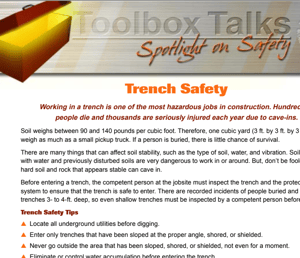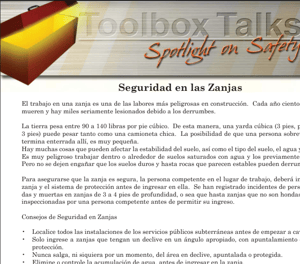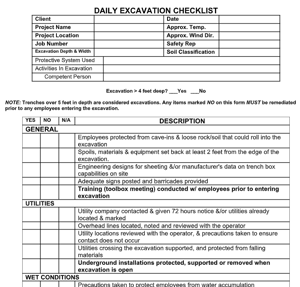Trench Safety Stand Down Resources
June is Trench Safety Month and June 15-19 is Trench Safety Stand Down week. We are partnering with NUCA (National Utility Contractors Association) to encourage everyone who does trenching or excavation as part of their work to participate in the Stand Down by holding a toolbox talk on trench safety. Here's how you can prepare for your stand down. (Remember, participating in the stand down by talking about safety is more important than when you do it.)
We're also making available a number of informational resources you can use as part of a safety talk or presentation (see below). Our webinar with NUCA about the trench competent person, as well as how you can help the rescue team should you need to call them had lots of great questions. We didn't have time to address all of them within the hour.
Below are the questions that we didn't get to discuss live, and the answers.
What is the maximum gap allowed between the dirt and backside of a trench box or sheet piling?
OSHA speaks to this issue in the standard and a Letter of Interpretation. From OSHA Standard 1926.652(g)(ii) requires that trench shields be installed “to restrict lateral or other hazardous movement.”
This Letter of Interpretation states " although our standard does not set a maximum distance between a shield box and a trench face, an employer would be required to ensure that, in the event of a collapse of the face, the shield would not move laterally. "
If you are sitting in an excavator inside the excavation, does it still need to be sloped in accordance with the standard?
Yes, OSHA requires that all employees that are exposed to soil collapse shall be protected from potential cave-in. In a Letter of Interpretation, OSHA does speak directly to pile-driving equipment and operations and states that the excavation must be sloped/protected.
We recently had a vendor come out selling inflatable trench panels. Anybody have experience with them, or an opinion on them?
We circulated this question among our trench rescue instructors, who are also active rescuers in municipal departments from New York to Idaho. We have not had first-hand experience with inflatable trench panels, either by demonstration or in actual use. Thank you for making us aware of this alternative equipment.
Is a Daily Excavation Safety Checklist required to be completed prior to work starting for the day?
The OSHA standard requires a daily inspection be completed prior to the start of work, after any rainstorm, dewatering activities, and after any hazard causing event.
If a trench box is installed, is it best to back fill around the box to prevent sudden failures of soil outside of the box from crashing into the box? In other words, fill the void spaces / eliminate soil momentum?
OSHA speaks to this issue in the standard and a Letter of Interpretation. From OSHA Standard 652(g)(ii) requires that trench shields be installed “to restrict lateral or other hazardous movement.”
The Letter of Interpretation states "although our standard does not set a maximum distance between a shield box and a trench face, an employer would be required to ensure that, in the event of a collapse of the face, the shield would not move laterally. "
Should excavations beyond 4 - 5 feet in depth be permit required confined spaces?
No. The OSHA Construction Industry Confined Space Standard Subpart AA 1926.1201(b)(1) states that the standard does not apply to construction work regulated by 1926 Subpart P—Excavations. However, an entity may choose to exceed OSHA’s minimum requirements and classify excavations/trenches as confined spaces. If an entity does apply the definition to a trench, then they are now required to follow all of the confined space requirements as stipulated in 1926.1200 Subpart AA.
More Resources
Here's a great 1-pager designed for a toolbox talk:
And here's the same 1-pager in Spanish:
This is a checklist you can use for planning and continuous monitoring of an open trench, and also a good topic of conversation to share with your team:
Questions? Reach out to us. We're here to help.
Stay Safe,
The Roco Rescue Team
IMPORTANT: The information at RocoRescue.com is provided as a complimentary service. It is a general information resource and is not intended as legal advice. Because standards and regulations relating to this topic are typically performance based, and compliance with those standards and regulation is often dependent on the specific circumstances and conditions at hand, it is always important to carefully review all relevant standards and regulations, and to follow the proper protocols specific to your company or agency.







